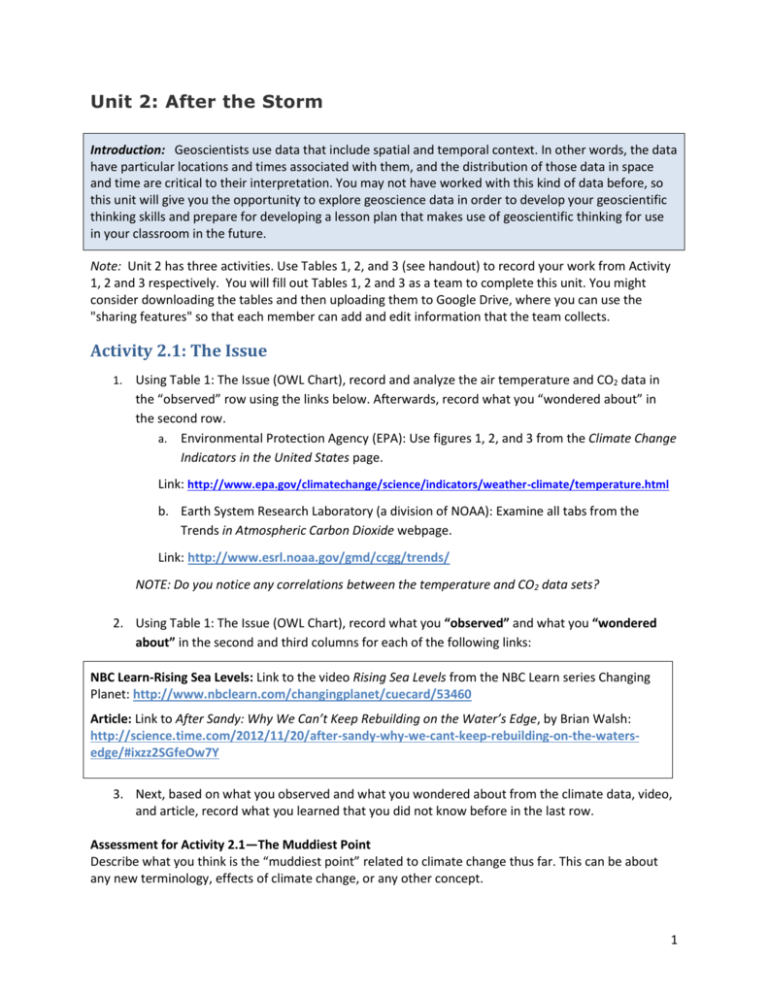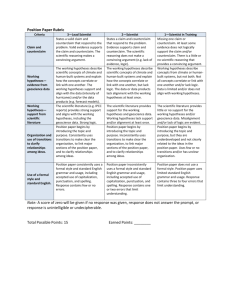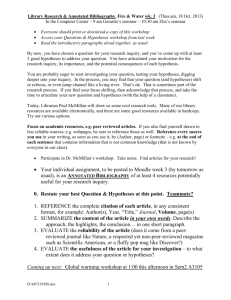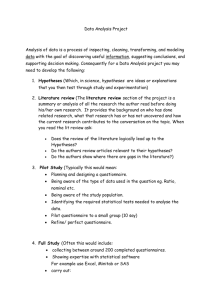After the Storm handout
advertisement

Unit 2: After the Storm Introduction: Geoscientists use data that include spatial and temporal context. In other words, the data have particular locations and times associated with them, and the distribution of those data in space and time are critical to their interpretation. You may not have worked with this kind of data before, so this unit will give you the opportunity to explore geoscience data in order to develop your geoscientific thinking skills and prepare for developing a lesson plan that makes use of geoscientific thinking for use in your classroom in the future. Note: Unit 2 has three activities. Use Tables 1, 2, and 3 (see handout) to record your work from Activity 1, 2 and 3 respectively. You will fill out Tables 1, 2 and 3 as a team to complete this unit. You might consider downloading the tables and then uploading them to Google Drive, where you can use the "sharing features" so that each member can add and edit information that the team collects. Activity 2.1: The Issue 1. Using Table 1: The Issue (OWL Chart), record and analyze the air temperature and CO2 data in the “observed” row using the links below. Afterwards, record what you “wondered about” in the second row. a. Environmental Protection Agency (EPA): Use figures 1, 2, and 3 from the Climate Change Indicators in the United States page. Link: http://www.epa.gov/climatechange/science/indicators/weather-climate/temperature.html b. Earth System Research Laboratory (a division of NOAA): Examine all tabs from the Trends in Atmospheric Carbon Dioxide webpage. Link: http://www.esrl.noaa.gov/gmd/ccgg/trends/ NOTE: Do you notice any correlations between the temperature and CO2 data sets? 2. Using Table 1: The Issue (OWL Chart), record what you “observed” and what you “wondered about” in the second and third columns for each of the following links: NBC Learn-Rising Sea Levels: Link to the video Rising Sea Levels from the NBC Learn series Changing Planet: http://www.nbclearn.com/changingplanet/cuecard/53460 Article: Link to After Sandy: Why We Can’t Keep Rebuilding on the Water’s Edge, by Brian Walsh: http://science.time.com/2012/11/20/after-sandy-why-we-cant-keep-rebuilding-on-the-watersedge/#ixzz2SGfeOw7Y 3. Next, based on what you observed and what you wondered about from the climate data, video, and article, record what you learned that you did not know before in the last row. Assessment for Activity 2.1—The Muddiest Point Describe what you think is the “muddiest point” related to climate change thus far. This can be about any new terminology, effects of climate change, or any other concept. 1 Activity 2.2: Investigating the Issue Introduction to the Issue Due to extreme weather events such as hurricanes, policy makers and private citizens, among others, wonder about the viability of spending billions of dollars of private and public money to rebuild coastal communities. For instance, Hurricane Sandy, which is anticipated to be the second costliest natural disaster, is estimated to cost at least $50 billion. This kind of weather event is hypothesized to be linked to climate change. To address the issue, the goal for this investigation is for you to write an evidencebased position paper that responds to the problem below. Problem: To what extent should we build and/or rebuild coastal communities? Position Paper Criteria: Write a 500-1000 word position paper that… Makes an argument and supports the argument with reasons and evidence. Demonstrates organization and use of transitions to clarify relationships among ideas. Demonstrates use of a formal style and standard English. General Guidelines: In groups of 2-3, follow the steps below (step 1, 2, 3…) to collect, organize, and analyze geoscience climate data and forecast models. This data is the evidence for your position paper. In addition, read the most recent scientific report from the Intergovernmental Panel on Climate Change (IPCC). This research is additional evidence for your position paper. Step 1: Select a study area In groups, select a coastal community study area. You may choose from the list below or choose a different study area of your choice (e.g. New Haven). Every group must select a different study area. East Coast Portland, ME New York, NY Outer Banks, NC Charleston, SC Miami, FL Gulf Coast Tampa, FL Mobile, AL New Orleans, LA Houston, TX Galveston, TX West Coast San Diego, CA Los Angeles, CA San Francisco, CA Astoria, OR Seattle, WA Step 2: Research the study area Use Google Earth and the Internet to describe the study area. You may divide the task from the list of guiding questions below. Record the group’s findings in Table 2: Investigating the Problem. Google Earth: How urbanized is your area (e.g. densely vs. sparsely)? Describe the topography (Use the 3D mode or hold the mouse over an area to show the elevation). What is the length of the shoreline (use the distance tool)? Has the urban area changed over time (use historical imagery tool)? Alternatively, you can also use the National Map View by going to http://viewer.nationalmap.gov/viewer/ in lieu of Google Earth. Note: Ask your instructor or review the resources at the end of this document for assistance if you need help with Google Earth the National Map Viewer. Internet: What is the population? Demographics? Urbanization? How has this changed over time? What is the economic output of the region? 2 Step 3: Research geoscience data Record a summary of the CO2 and temperature trends from Table 1: The Issue into Table 2: Investigating the Problem. Include the temperature data from your study area, too. Then, divide Data Set 1, 2 and 3 (see below) among the group members. For each data set, read the “Data Collection Procedures” and “Guided analysis Questions” for assistance. After you collect the data, construct a graph for each data set. Record the summaries and analyses of the data in Table 2. NOTE: If you are unfamiliar with Google Earth, KML/KMZ files, or MS Excel graphing, you might want to use the Data Analysis Resources at the end of this handout. Ask your instructor for guidance, too. Data Set 1: Sea Level Link: http://tidesandcurrents.noaa.gov/kml/coops-slt.kmz Data Collection Procedure: The “up” or “down” arrows indicate locations with sea-level data; select a minimum of three cities at/near your location. Select two or three locations outside of your area for comparison. Create a table and/or graph based on the guided questions below. Guided Analysis Questions: What is the lowest recorded sea level data? When? What is the highest? When? What time range was the data collected? What is the rate of sea level change over this time period? How do the data differ among all selected locations? How are they similar? Data Set 2: Greenland Ice Sheet Link: http://mw1.google.com/mw-earth-vectordb/outreach/cop16tours/greenland_ice_melt_1980_2007.kmz Data Collection Procedure: Calculate the area with ice melt for 1985. Under “My Places,” from the left-hand menu, right click on the icon and add a folder and title it (e.g. Greenland Ice Sheet). Click on the “add polygon” tool from the top menu bar. Create a polygon (four to five sides) of the area with ice melt (NOTE: You will need to make multiple polygons since it will be impossible to create one that accurately covers the desired area). When the pop-up window appears, label it (e.g. Area A). Once all of the polygons are created, copy the entire folder (with all of the polygons). Go to http://www.earthpoint.us/Shapes.aspx and paste this polygon folder into the text box. Under output, click on square miles. Then, use the “calculate result,” and click on “view webpage” or view “Google Earth.” Add the square miles for each polygon to calculate the total square miles. Repeat the steps for 1990, 1995, 2000, and 2005. Create a graph to organize your data. A tutorial for the above directions is at: https://www.youtube.com/watch?v=fnuRQE0_cIU . Guided Analysis Questions: How did the amount of days with ice melt change over the past several decades? What can you infer within the five-year interval? 3 Data Set 3: Intensity of Tropical Cyclones (Hurricanes) Link: http://wind.mit.edu/~emanuel/Atlantic_SST_PDI_1949-2009.xls The data from the link above is the Atlantic tropical cyclone power dissipation and Main Development Region (MDR) sea surface temperature (SST) from 1949 to 2009. Below are key terms. A tropical cyclone is defined as a system that originates over tropical ocean waters and can develop into a destructive storm, which is known in the U.S. as a hurricane. Power dissipation is defined as the sum of the maximum one-minute sustained wind speed cubed, at six-hourly intervals, for all periods when the cyclone is at least tropical storm strength (minimum of 34mph). MDR is defined as the region bounded by 6N and 18N, and 20W and 60W; note that the SST data is averaged from August through October of each year. Data Collection Procedures: Use Google Earth and describe where the MDR is located. Download the data spreadsheet (click on link). An MS spreadsheet will appear with three columns of data including: 1) Years, 2) the MDR SST, and the 3) Power Dissipation. Please follow the instructions below to create the graph. o Highlight only the “MDR SST” and “Power Dissipation” data, including the labels (e.g. MDR SST). Click on the “Insert” tap at the top of the page. o Click on “Line.” Several options will appear. Click on “stacked line” option. A graph will appear—but the graph will not be organized properly. o To organize the graph, double click on the “Power Dissipation” line on the graph itself. A box will appear titled “series options.” Click on “secondary axis.” A double line graph will appear with the MDR SST labels on the left-hand side and the Power Dissipation labels on the right-hand side. o Next, fix the horizontal or x-axis. To do this, right click on the horizontal or x-axis. A menu will appear. Click on “select data source.” Click the “edit” button on the horizontal axis labels. A new box will appear, “axis labels.” Highlight the year column from 1949-2009 from the MS Excel sheet (do not highlight “year”) and hit “ok.” o Finally, use the “layout tab” at the top of the page to label all axes and to create a title. Guided Analysis Questions: What is the relationship between sea surface temperature and wind power? Is there a correlation between the two variables? Step 4: Research geoscience forecast models Analyze the forecast models from the National Center for Atmospheric Research (NCAR) Community Climate System Model (see link below). Use the air temperature anomaly models from various “scenarios” (e.g. low/ high CO2 emissions). Examine the U.S. data and global data. Record your findings in Table 2. NCAR Community Climate System Model Link: http://gis.ucar.edu/data/climate/kml Also, analyze the sea level change model from United States Geological Survey (USGS) Sea Level Rise Animations (see link below). It is best to click onto the state (e.g. CT, NY, FL) that you are investigating. Record your findings in Table 2. USGS Center of Excellence for Geospatial Thinking link: http://cegis.usgs.gov/sea_level_rise.html 4 Step 5: Construct initial working hypotheses As a group, create a list of three or more “initial working hypotheses” that respond to the problem: To what extent are coastal communities at risk due to climate change? Record these initial hypotheses in Table 2. Consider the following questions when constructing your initial working hypotheses: 1. What data sets (e.g. intensity of hurricanes) or products (forecast models) correlate or link to one another? 2. Do certain data sets/products seem to affect other (e.g. feedback loops)? To what extent? 3. How robust are these correlations, links, and feedback loops? What is the level of certainty? 4. How might the working hypotheses predict the future of climate change from your community? Step 6: Research the literature Read the Intergovernmental Panel on Climate Change (IPCC) report titled: Summary for Policy Makers. You may divide the task among/between your group members. If you divide the task, you must teach what you learned to your teammates. Record all summaries in Table 2. Link: http://report.mitigation2014.org/spm/ipcc_wg3_ar5_summary-for-policymakers_approved.pdf Note: To learn more about the IPCC, go to http://www.ipcc.ch/index.htm. Optional Research Research the literature about climate change and tropical cyclone intensity AND the costs of rebuilding coastal communities (both claims and counter claims). Divide the tasks of researching the literature. Take individual notes to share with the “study area” group. Climate Change and Tropical Cyclone Intensity The two links below will provide more information on climate change and tropical cyclone activity. Climate Change Indicators in the United States: Tropical Cyclone Activity: Link: http://www.epa.gov/climatechange/science/indicators/weather-climate/cyclones.html Kerry Emanuel: Papers, Data, and Graphics Pertaining to Tropical Cyclone Trends and Variability: Link: http://eaps4.mit.edu/faculty/Emanuel/publications/tropical_cyclone_trends Cost of Rebuilding Literature: Below are selected links about the costs of rebuilding coastal communities. Collect additional articles that provide the case for and against rebuilding coastal communities. Calculating the True Cost of Global Climate Change Link: http://e360.yale.edu/feature/calculating_the_true_cost_of_global_climate_change/2357/ East Coast Rebuilding, Vulnerable to Future Sandy’s Link: http://www.nbcnews.com/id/51574383/ns/technology_and_science-science/t/east-coastrebuilding-vulnerable-future-sandys/ Will Climate Change Increase Damage Costs? Link: http://www.accuweather.com/en/weather-news/hurricane-cost-rising-climatechange/63881 5 Step 7: Construct a Climate Change Concept Map of your study area With your "study area" group, construct a concept map on poster paper with the evidence collected. This map must have links that depict the relationships (e.g. feedback loops*) among the parts of the climate system as well as the human-built system (e.g. coastal communities). *For more about feedback loops, please go to: http://serc.carleton.edu/introgeo/models/loops.html Construction Procedures 1. Based on what you have learned thus far, create a list of as many concepts that you can think of. Consider the following questions. Note: You may record these concepts on post-its. o What concepts correlate or link with one another? o Do certain concepts seem to affect other concepts (e.g. feedback loops)? To what extent? o How robust are these correlations, links, and feedback loops? What is the level of certainty? o How might the working hypotheses predict the future of climate change from your community? 2. From the list of concepts, organize and group related concepts. 3. Connect related concepts using lines with arrows that show a direct relationship. 4. Label each line with words or short phrases that describes the relationship between two or more concepts (e.g. how one concept affects another concept). Evaluation Procedures 5. Examine the “lines” and “arrows” that link the concepts to make sure they are valid. 6. Rearrange and remove concepts to simplify the concept map. 7. When you are satisfied with your concept map, make sure it is neat and clear. Step 8: Feedback from peers Post your group’s concept map. Each “study area” group will then evaluate other “study area” group’s concept maps. Record what you “agree” with as well as what you “question” on post-it notes and place them on the concept map. After all of the group evaluations are complete, review the comments from your concept map. Take notes regarding the “agrees,” “questions” as well as any other comments that were posted. Finally, make final revisions to your concept map. Step 9: Revise the working hypotheses and making claims Reexamine the “initial working hypotheses” from Table 2. In light of the new evidence, create a list of three or more revised hypotheses based on your concept map that provides evidence to answer the problem: To what extent should we build and/or rebuild coastal communities? Finally, cite a final claim that you wish to state based on you final working hypotheses that clearly answers the problem. Record this in the last row of Table 2. Assessment for Activity 2.1: I used to think…but now I know Create a T-chart. On the left-hand side, write “I used to think” and on the right-hand side, write “but now I know.” Record at least three ideas for each side of the T-chart. 6 Activity 2.3: Constructing Your Argument Write a position paper to respond to the socio-scientific issue: To what extent should we build and/or rebuild coastal communities? As a group, complete Table 3: Constructing Your Argument. Each member should complete their own Table. After you complete Table 3, independently write your 500-1000 word position paper. Review the criteria in the left-hand column as well as the performance levels. Position Paper Rubric Criteria Claim and counterclaim Working hypotheses— evidence from geoscience data Working hypotheses— support from scientific literature Organization and use of transitions to clarify relationships among ideas. Use of a formal style and standard English. 3—Lead Scientist States a valid claim and counterclaim that responds to the problem. Valid evidence supports the claim and counterclaim. The scientific reasoning makes a convincing argument. The working hypotheses describe scientific concepts of climate and human-built systems. Explains how the concepts correlate or link with one another. The working hypotheses support and align with the data (intensity of hurricanes) and/or the data products (e.g. forecast models). The scientific literature (e.g. IPCC reports) provides strong support and aligns with the working hypotheses, including the geoscience data. Strong logic. Position paper begins by introducing the topic and purpose. Consistently uses transitions to make clear the organization, to link major sections of the position paper, and to clarify relationships among ideas. Position paper consistently uses a formal style and standard English grammar and usage, including accepted use of capitalization, punctuation, and spelling. Response contains few or no errors. 2—Scientist States a claim and counterclaim that responds to the problem. Evidence support claim and counterclaim. The scientific reasoning does not make a convincing argument (e.g. lack of evidence, logic). The working hypotheses describe scientific concepts of climate and human-built systems. Explains how the concepts correlate or link with one another, but lacks logic. The data or data products lacks alignment with the working hypotheses at least once. 1—Scientist in Training Missing one claim or counterclaim. At least some evidence does not logically support the claim and/or counterclaim. There is a little or no scientific reasoning that provides a convincing argument. Working hypotheses describe concepts from climate or humanbuilt systems, but not both. Not all concepts correlate or link with one another and/or lack logic. Data is limited and/or does not align with working hypotheses. The scientific literature provides support for the working hypotheses and geoscience data. Working hypotheses lacks support and/or alignment at least once. Position paper begins by introducing the topic and purpose. Inconsistently uses transitions to make clear the organization, to link major sections of the position paper, and to clarify relationships among ideas. The scientific literature provides little or no support for the working hypotheses and/or geoscience data. Misalignment and/or lack of logic are evident. Position paper inconsistently uses a formal style and standard English grammar and usage, including accepted use of capitalization, punctuation, and spelling. Response contains one or two errors that limit understanding. Position paper does not use a formal style. Position Paper uses limited standard English grammar and usage. Response contains three to four errors that limit understanding. Position paper begins by introducing the topic and purpose, but they are underdeveloped and not clearly related to the ideas in the Position Paper. Uses few or no transitions and/or has unclear organization. Note: A score of zero will be given if no response was given. Response does not answer the prompt. Response is unintelligible or undecipherable. Total Possible Points: 15 Earned Points: ________ 7 Data Analysis Resources: Google Earth Google Earth User Guide: http://serc.carleton.edu/sp/library/google_earth/UserGuide.html Drawing Paths and Polygons: http://support.google.com/earth/bin/answer.py?hl=en&answer=148072&topic=2376756&ctx=topic Elevation Profiles http://support.google.com/earth/bin/answer.py?hl=en&answer=181393&topic=2376756&ctx=topic Measuring Distances and Area: http://support.google.com/earth/bin/answer.py?hl=en&answer=148134 Measuring Tools Features and Options http://support.google.com/earth/bin/answer.py?hl=en&answer=148135&topic=2376756&ctx=topic Printing and Saving Maps: http://support.google.com/earth/bin/answer.py?hl=en&answer=1067229&topic=2376764&ctx=topic The National Map Viewer: http://viewer.nationalmap.gov/viewer/ KML or KMZ files About KML: http://support.google.com/earth/bin/answer.py?hl=en&answer=148118&topic=2376017&ctx=topic KML Tutorial: https://developers.google.com/kml/documentation/kml_tut MS Excel How to Make Graphs in MS Excel http://serc.carleton.edu/sp/library/mathstatmodels/xlhowto.html 8




